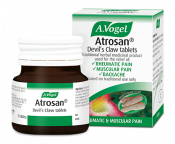A.Vogel search
When the internal search is activated, personal data such as your IP address is transmitted to our search engine Cludo. Data is thus transferred to a third country. Please click here if you want to display the internal search. You can find more information on data protection here: Privacy policy.
Diet and lifestyle changes for muscle and joint pain
Many of us suffer from muscle stiffness, aches and pains at some point in our lifetime. Whilst for most these pains are usually short lived, most would agree that the sooner they can be resolved the better!
So, what can you do to help yourself? Here are a number of changes you can make to your diet and lifestyle to help keep your muscles and joints moving:
Eat more:
Oily fish such as herring, mackerel, salmon, tuna, or use fish oil supplements.
Why? These contain oils which have a positive effect on inflammation.
Eat more:
Sardines, green leafy vegetables, oats, kidney beans and dried fruit such as figs, pumpkin, sunflower seeds.
Why? Foods rich in magnesium help ensure better calcium absorption. Green leafy vegetables also contain potassium, which reduces acidity in the body.
Eat more:
Pineapple, papaya, mango, guava.
Why? Contain digestive enzymes which help reduce acidity in the body.
Use:
Molkosan® Vitality.
Why? Prebiotics encourage a healthy digestive tract, supporting good bacteria in the gut. When these bacteria flourish your digestive system works better.
Have more:
Physical exercise and relaxation time.
Why? A regular (even gentle) exercise routine such as swimming, stretching, tai-chi, yoga or walking can reduce stress and help you relax. This helps keep your joints moving better.
 Looking for a solution to to help relieve symptoms such as muscle and joint pain, backache, rheumatic pain and lumbago?
Looking for a solution to to help relieve symptoms such as muscle and joint pain, backache, rheumatic pain and lumbago?
Buy now from your local store.
“I have used these for several years and would not wish to be without them.”![]()
To find local independent stores in your area that sell Atrosan Devil’s Claw tablets, simply type your postcode below.

How healthy are you?
Take our quick quiz to discover just how healthy your immune system is, as well as some useful information about your general health and wellbeing!





